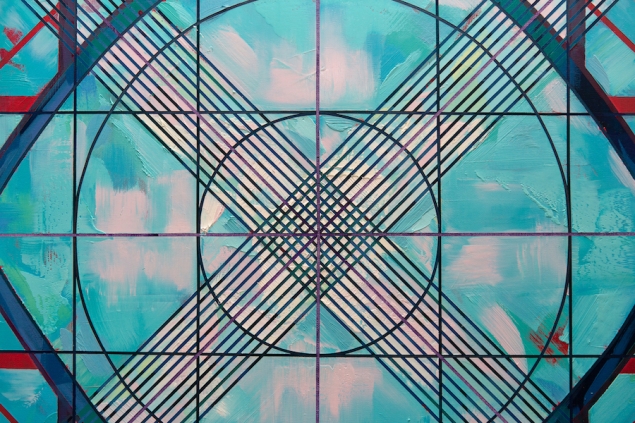Throughout spring and summer 2020, Connective Spaces, Liverpool Street Station by Seçil Erel will hang in Avenue Restaurant as part of a new exhibition celebrating some of our most promising abstract painters. To mark the occasion, I wanted to dig a little deeper into what makes this, and the artist’s practice in general, so special.
Connective Spaces, Liverpool Street Station
Formally, the work is a perfect example of Secil’s accomplished style of painting which marries Abstract Expressionism’s freedom of colour and texture with the controlled, calculated geometry of Minimalism. At the top of the canvas is a beacon of whitish pink, which intensifies as it tapers to a deep red towards the bottom. This form is regularly interrupted by a gridlike network of hard blue and green lines, which creep over from a dense lattice of more such lines that stretch to the edges and bottom of the work.

Liverpool Street Station
However, there is more to this painting than its formal qualities. It contains within it the key tension between past, present and future that Secil has come to navigate with nuance and sensitivity, justifying her place in this exhibition.
Seçil in her studio
As the title suggests, the work is not a pure abstraction; it is based on a ground plan of Liverpool Street Station. This is where the artist first arrived with her daughter when she moved from Istanbul to London in 2017, the blue and green network represents the railway tracks that led her into the city.
Close up of Flower of Life 2 by Seçil Erel
Abstract art is generally thought, as the name suggests, to abstract from the world. Secil’s paintings do not fit the usual view of abstraction. Like Connective Spaces references the moment she arrived in London, each of Secil’s works represents a concrete moment in her life. These moments are points on a personal timeline, connected to other moments. As such, they cannot be viewed as isolated abstract shapes on canvas.
Flower of Life 1 beside Flower of Life 2 in Secil's studio
Like the train station is defined by the tracks running in and out of it from around the country, Secil’s works are linked to the wider context of her own life. As she puts it, “I can't separate my life and work.”

Here, tension is revealed: Secil paints the here and now, the distinct moments of her life. “When I paint,” she says, “there is nothing else.” These moments cannot be taken to be abstract, they are always linked to the past and future. She cannot isolate the present moment from the wider timeline of moments that have led up to it and moments that it will lead to.

This is a tension that Secil feels “every second of every day” and does not shy away from when talking about her work. She gladly admits that paintings such as Connective Spaces “change the reality of [her] past experiences by transforming and carrying them in a fruitful way to the future”.

Inside Seçil’s studio
In a text written for Seçil’s 2019 exhibition A Separate Reality at Istanbul’s Milli Reasuran gallery, curator Fatos Ustek describes her work as representing a “surrender in the flow of things.” It is precisely this surrender, this facing up to the fact that her autobiographical paintings cannot escape their relationship with the wider flow of her life that makes them special. As Üstek puts it, “contemplating on the here and now provides a gateway to re-placing the past and the future”.




